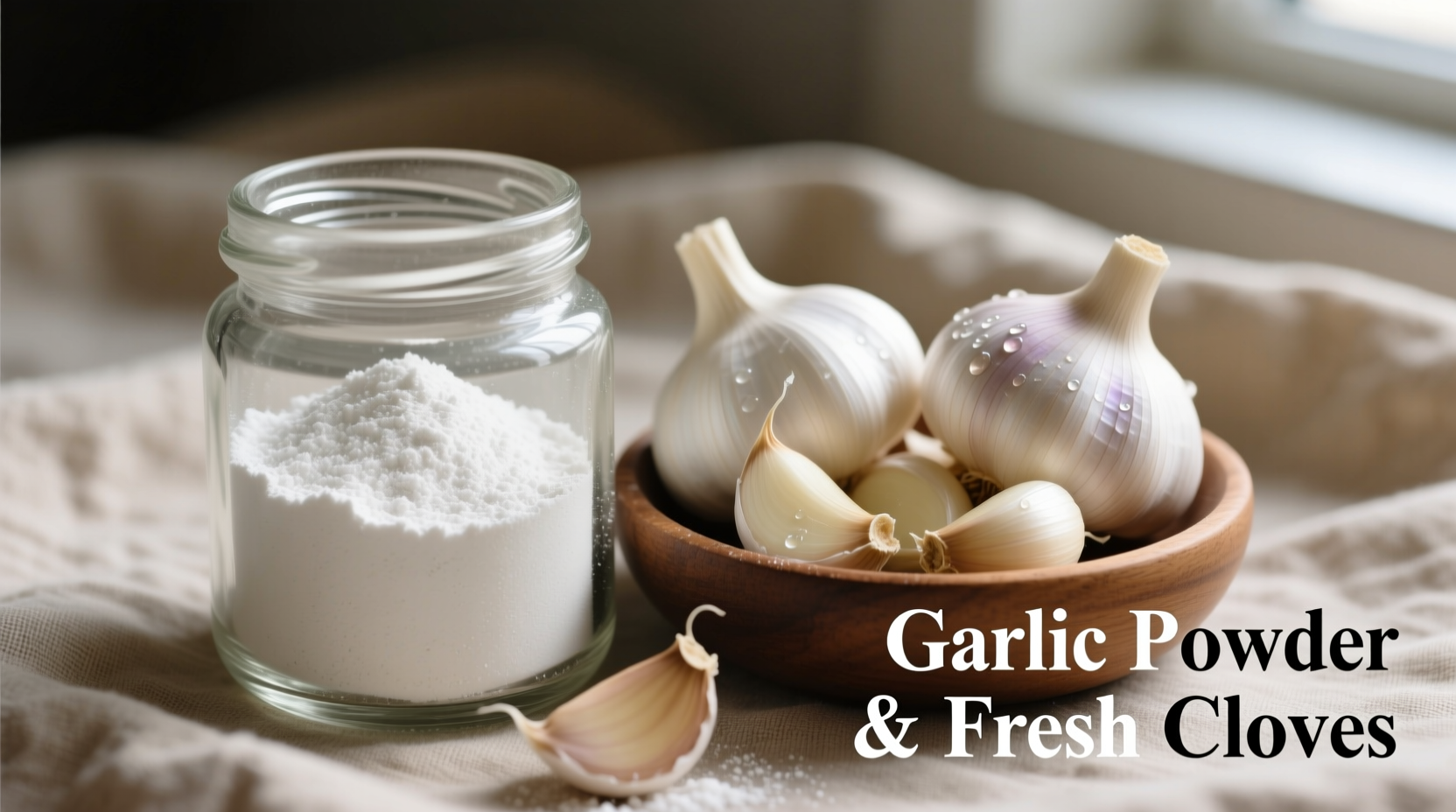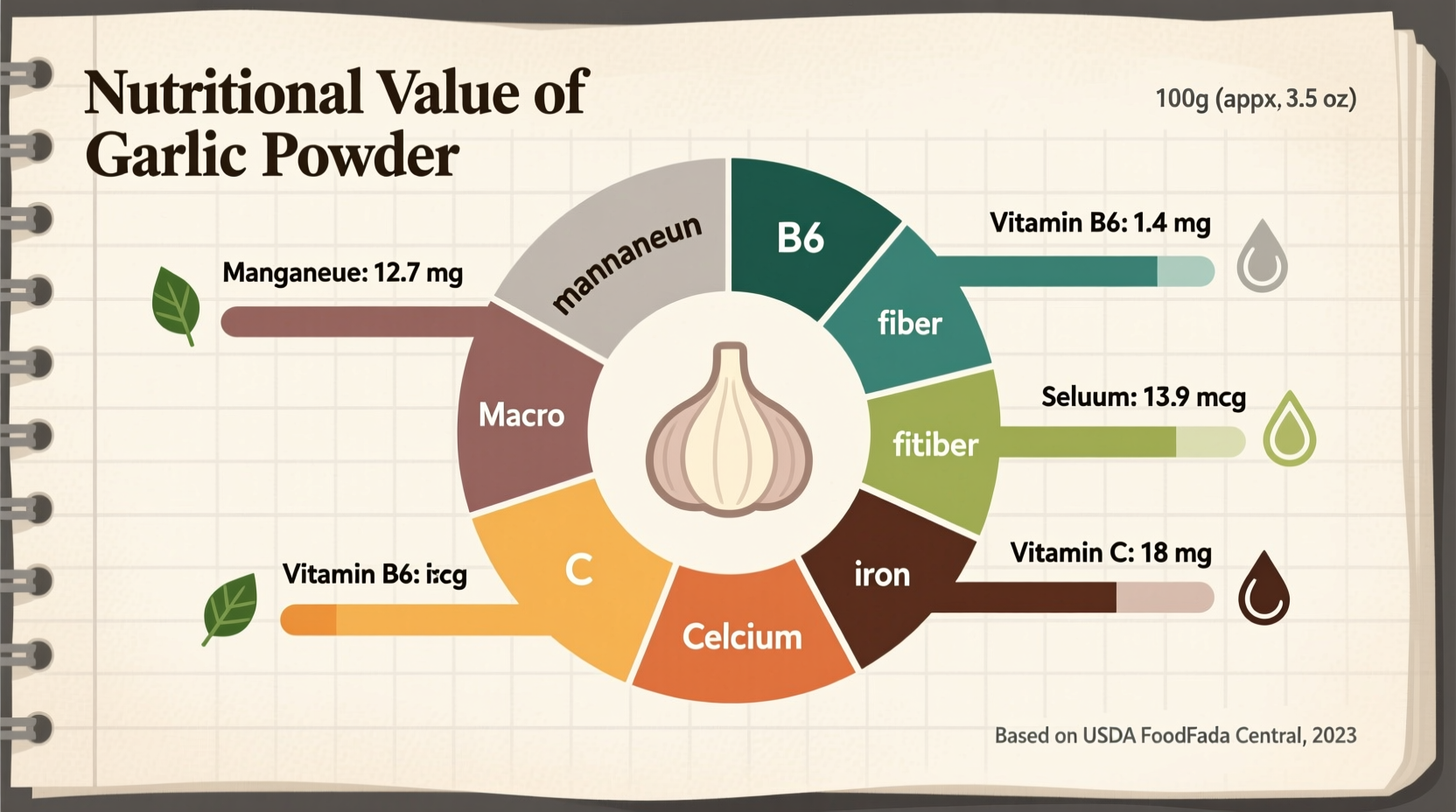Curious about how that sprinkle of garlic powder in your recipes contributes to your nutrition? Understanding the precise nutritional profile of this kitchen staple helps you make informed cooking decisions while maximizing health benefits. Unlike vague online claims, this guide delivers scientifically verified data from authoritative sources to help you leverage garlic powder's full potential.
Garlic Powder Nutrition: Complete Breakdown
Garlic powder maintains many of fresh garlic's beneficial compounds while offering shelf stability and convenience. According to USDA FoodData Central, the complete nutritional profile per 100g reveals why this pantry essential deserves attention:
| Nutrient | Amount per 100g | Daily Value % |
|---|---|---|
| Calories | 334 | 17% |
| Total Fat | 0.6g | 1% |
| Carbohydrates | 74.6g | 27% |
| Dietary Fiber | 6.5g | 23% |
| Sugar | 2.0g | - |
| Protein | 17.9g | 36% |
| Manganese | 1.67mg | 73% |
| Vitamin B6 | 1.24mg | 73% |
| Selenium | 14.2μg | 26% |
| Calcium | 181mg | 14% |
| Potassium | 1190mg | 25% |
Source: USDA FoodData Central, Entry #03408
Garlic Powder vs Fresh Garlic: Nutritional Comparison
Many home cooks wonder how dehydrated garlic compares to fresh cloves. The drying process concentrates certain nutrients while reducing others:
| Nutrient | Garlic Powder (1 tsp) | Fresh Garlic (1 clove) | Key Difference |
|---|---|---|---|
| Calories | 10 | 4 | Concentrated due to water removal |
| Allicin Potential | Moderate | High | Enzyme activation requires moisture |
| Vitamin C | Trace | 1.1mg | Heat-sensitive vitamin degrades during drying |
| Manganese | 0.05mg | 0.02mg | Concentrated mineral content |
| Shelf Life | 2-3 years | 3-6 months | Practical storage advantage |
Research published in the Journal of Agricultural and Food Chemistry confirms that while garlic powder contains alliin (the precursor to allicin), the active compound forms only when rehydrated during cooking. This explains why recipes requiring immediate pungency work better with fresh garlic, while slow-cooked dishes benefit equally from powder.
Health Benefits Backed by Research

Garlic's therapeutic properties have been documented since ancient times, but modern science provides specific insights about garlic powder's benefits:
Cardiovascular Support
A 2020 meta-analysis in Nutrients reviewed 11 clinical trials and found that aged garlic extract (closely related to powder compounds) reduced systolic blood pressure by 5-8 mmHg in hypertensive patients. The sulfur compounds in garlic powder help relax blood vessels and improve circulation.
Antioxidant Properties
Garlic powder contains multiple organosulfur compounds that combat oxidative stress. According to research from the National Center for Biotechnology Information, these compounds increase glutathione levels - the body's master antioxidant - by up to 30% with regular consumption.
Digestive Compatibility
Unlike raw garlic which can cause digestive discomfort for some, garlic powder offers a gentler alternative. A study in the World Journal of Gastroenterology noted that processed garlic products caused significantly fewer gastrointestinal symptoms while maintaining therapeutic benefits.
Practical Usage Guidelines
Understanding garlic powder's nutritional profile helps optimize its use in your cooking routine:
Maximizing Nutrient Availability
- Add to dishes with liquid components (sauces, soups) to activate allicin formation
- Combine with healthy fats (olive oil, avocado) to enhance absorption of fat-soluble compounds
- Avoid excessive heat exposure - add during last 5-10 minutes of cooking
Appropriate Culinary Applications
Garlic powder shines in specific cooking scenarios where fresh garlic falls short:
- Dry rubs for meats (even distribution without burning)
- Baked goods where fresh garlic would create moisture pockets
- Long-simmered sauces where fresh garlic would become bitter
- Emergency substitutions when fresh garlic isn't available
Important Considerations and Limitations
While versatile, garlic powder has specific constraints you should understand:
Context Boundaries for Optimal Use
Garlic powder isn't universally interchangeable with fresh garlic. Consider these limitations:
- Raw applications: Cannot replicate fresh garlic's sharp bite in salad dressings or aioli
- Flavor intensity: 1/8 teaspoon powder ≈ 1 fresh clove (adjust carefully to avoid overpowering)
- Chemical differences: Lacks the immediate enzymatic reaction of fresh garlic
- Nutrient degradation: Vitamin C content significantly reduced during dehydration
Quality Variations Between Brands
Not all garlic powders deliver equal nutritional value. The National Library of Medicine notes that processing methods affect compound retention:
- Air-dried powders retain more alliin than freeze-dried varieties
- Organic certification correlates with higher sulfur compound concentrations
- Finer grinds increase surface area and potential nutrient availability
Conclusion: Making Informed Choices
Garlic powder offers a nutritionally valuable, shelf-stable alternative to fresh garlic with specific advantages for certain cooking applications. By understanding its precise nutritional profile and limitations, you can strategically incorporate it into your diet to maximize health benefits while enhancing flavor. Remember that one teaspoon provides meaningful amounts of manganese, vitamin B6, and selenium - making it more than just a flavor enhancer but a genuine nutritional contributor to your meals.











 浙公网安备
33010002000092号
浙公网安备
33010002000092号 浙B2-20120091-4
浙B2-20120091-4